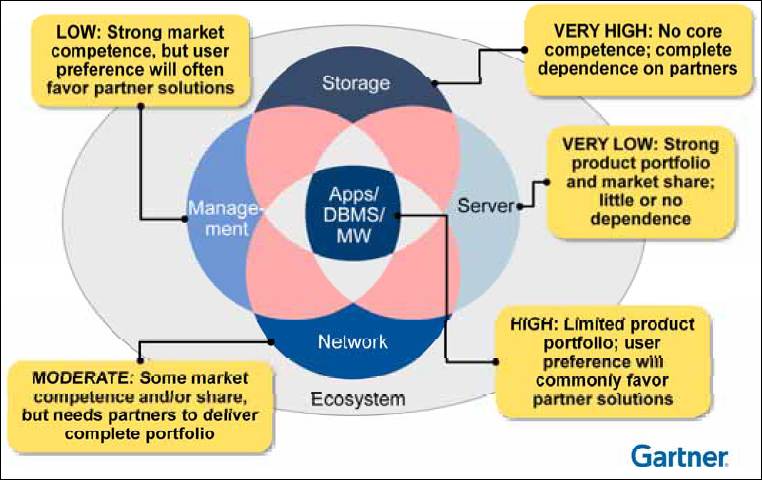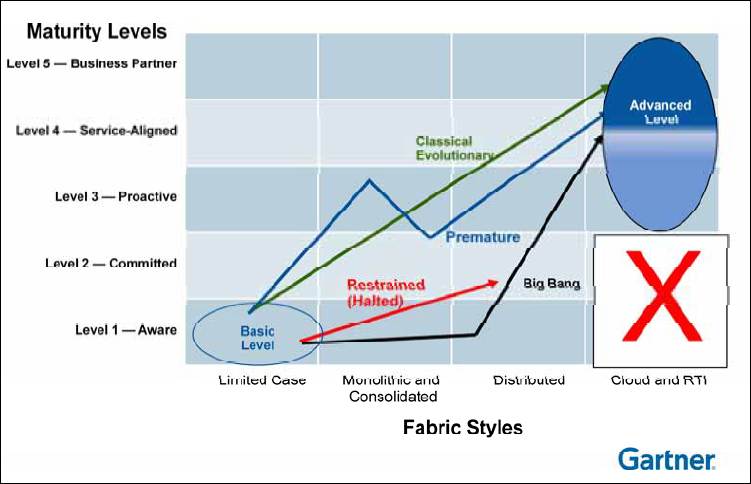Gartner’s fabric computing insights
According to Gartner, fabric computing has evolved over the past two years, and is here to stay. Read further for fabric computing implementation insights.
The emergence of fabric computing over the past couple of years has brought about a shift in the traditional role of a data center professional. Today, organizations are in a dilemma whether or not to invest in fabric computing technologies. This tip offers answers to the common fabric computing related questions, along with in-depth insights.
What is fabric computing?
Fabric computing translates to fabric based infrastructure (also called converged infrastructure or integrated systems). It implies bringing together server, storage and networking technology in the data center. Traditionally, we have witnessed integration at the hardware or horizontal level. Fabric computing involves integration at the vertical level, which is designed to deliver most of the packaged components — out of the box.
Fabric computing or integrated systems have various components—storage, server, networking, applications, DBMS, middleware and management. A true integrated system will have at least three components (See Figure 1: Components of an integrated system.)
Figure 1: Components of an integrated system
Why fabric computing?
Gartner believes that by 2015, fabric computing may account to 35% of total server shipment value. Due to this, Gartner has identified two reasons in favor of fabric computing investments:
- Speedy deployment: With all the integrated components, fabric computing deployment is quick. There is better mobility, and you can easily move workloads across the organization. Implementing fabric computing is easier in the virtualized environment.
- Increased capacity utilization: Fabric computing can be managed by a single person, as opposed to three different administrators handling different solutions.
Challenges to fabric computing
The traditional ROI model doesn’t make sense with fabric computing. Today, you may have separate TCO models for your servers, storage and networking. With the new technology, you cannot determine if you must look at these components individually or as a whole.
The second biggest challenge is vendor lock-in. If you buy Cisco UCS or VCE, you will be locked to that particular vendor. Fabric computing is a survival strategy for vendors as they struggle with profit margins. Through this technology, they can drive influence in your infrastructure.
You cannot indulge in customization, as these fabric computing components aren’t too flexible. It may also impact datacenter administrators’ jobs and responsibilities, as you will require just a single admin.
It’s unrealistic to expect vendors to have minimal partner dependencies. Irrespective of whether you plan to implement stand-alone servers or servers as part of fabric computing, consider the partnership dependencies of your vendor (See Figure 2: Decision frameworks to assess vendor partnerships). The higher their dependency, the more you should analyze the longevity of partnerships. You could address this by taking written support pledges.
Figure 2: Decision frameworks to assess vendor partnerships
The way forward
There are three approaches to fabric computing—premature, big bang and evolutionary. Premature approach is exercised by organizations lower on the maturity scale (See Figure 3: Fabric styles versus maturity levels). The big bang approach implies taking on a full scale implementation of fabric computing. At Gartner we recommend the evolutionary approach. Consider technology, processes, people and your business before taking on this journey.
Look at modernizing your IT infrastructure in areas where traditional silos continue to exist. You don't have to replace your entire infrastructure. Take the 90:10 approach, where 90% is your existing infrastructure. Try fabric computing with the other 10%, where you use non-mission critical applications and systems.
Don’t opt for highly vertical solutions; go instead for best-of-breed. Choose loosely integrated solutions with a component from vendor X and another from vendor Y. Let these two vendors integrate the system. Consider the example of VCE, which is a pre-integrated and pre-tested system. This highly inflexible system can’t work around customization. But definitely you might gain some speed of deployment there. On the other hand, a loosely integrated system like the VMware, Cisco, Netapp (VCN) you might have some work to do upfront. But that allows customization before deployment.
Figure 3: Fabric styles versus maturity levels
Best practices
- Use cases for proof of concept (POC): Choose non-mission critical applications for testing. If you have 100 applications, identify the low hanging fruits for these POCs.
- Multiple vendors: Try out at least two vendors for the POC. This will give you a full perspective of the fabric computing components.
- Cross functional teams: Involve cross functional teams in the POC to ensure a broader scope of the technology within your organization.
- Organizational culture: Understand your organizational culture and map out a risk model according to your organization’s maturity level. Only then should you embark on this journey.
- Understand the tools: Some vendors may have automated tools. Ensure that the new tools are compatible with existing tools in your environment.
- Roadmap: Obtain a roadmap for the entire fabric computing project. This will ensure that you don’t get carried away by tall promises. The vendor and your organization can focus on the declared roadmap.
About the author: Naveen Mishra is a principal analyst with Gartner's global data center convergence Team. He primarily focuses on analyzing data center technologies for the Asia/Pacific region.
Note: This tip is based on an excerpt of Naveen Mishra’s session at the Gartner IT Infrastructure Operations & Data Center Summit 2012 in Mumbai.
(Compiled by Mitchelle R Jansen.)












